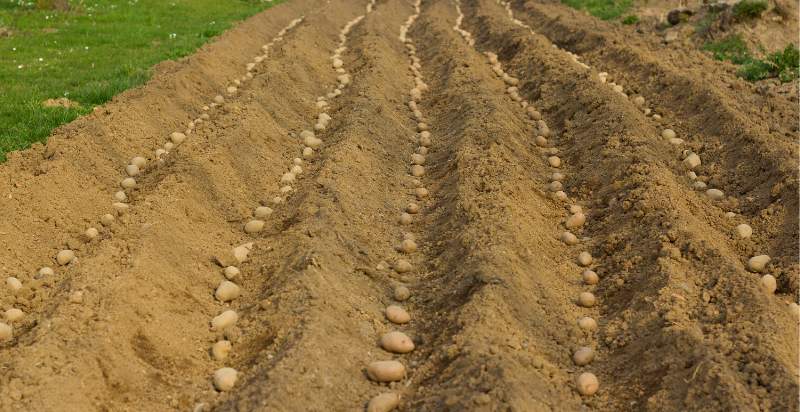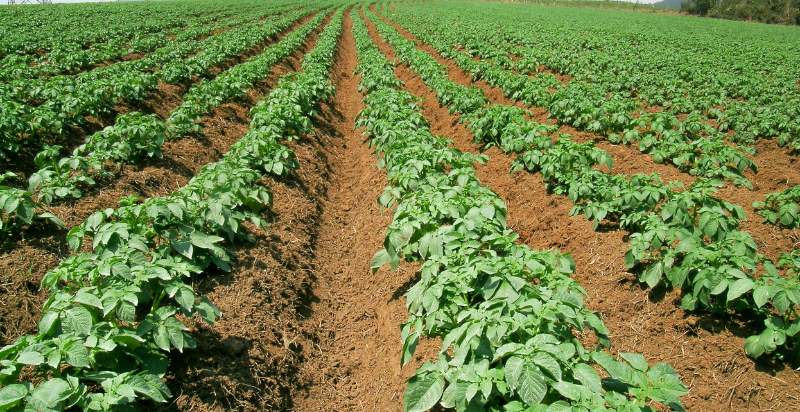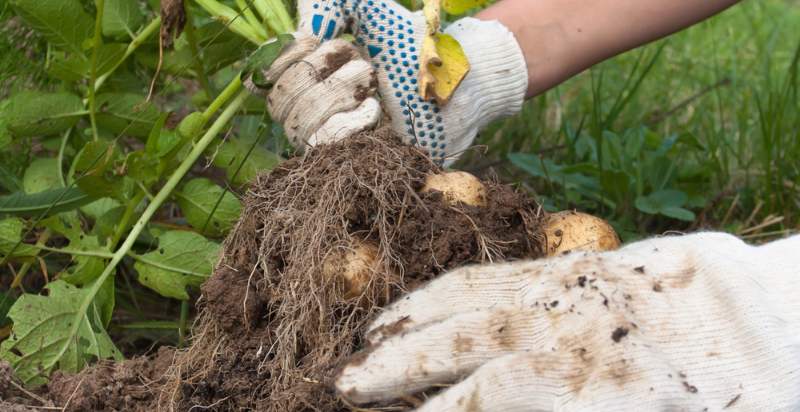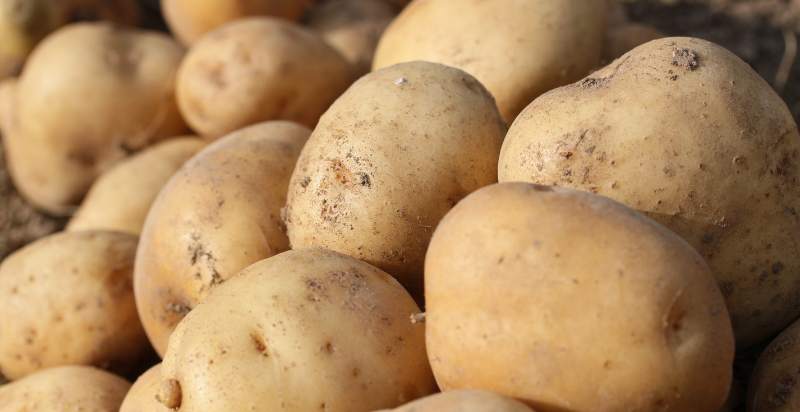Looking to add a touch of green to your garden or patio? Consider planting potato plants! These lush, vining plants are easy to grow and require little care. This article will provide an overview of how to plant and care for potato vines. We will also discuss some of the benefits of growing potatoes. So, read on to learn more!
The perennial nightshade Solanum tuberosum produces the starchy, tuberous crop known as the potato. The term “potato” can describe either the plant or the edible tuber. There are some other closely related cultivated potato species in the Andes, where the species is native. In the second half of the 16th century, the Spanish brought potatoes to Europe. They now form a significant portion of the global food supply and are a staple food in many regions.
Description:
The potato plant has a branched stem with small leaves arranged in a spiral on the main stem and larger leaves at the base of the plant. Each small leaf has a bud in its axil from which a flower or branches may grow. The potato flowers are white or purple and have five petals. The fruit is a berry with many seeds.
The potato plant grows to 60–90 cm (2.0–3.0 ft) tall, depending on the cultivar, with the leaves dying back after flowering, fruiting, and tuber formation. They spread by above-ground stolons and produce new shoots from the eyes of the tubers in the soil.
Tubers:
Depending on the cultivar, the tubers vary in size, shape, and color; they are generally oval or oblong with smooth or waxy surfaces and are white, yellow, pink, or red. They are mostly starchy with a small amount of protein and fat. A medium-sized potato typically contains about 80% water, 15% carbohydrates (including 1% dietary fiber), 2% protein, and trace amounts of vitamins and minerals.
Cultivation:
Potatoes are grown in temperate climates around the world. They are the world’s fourth largest food crop, following maize, wheat, and rice.
The potato is thought to have been domesticated independently in multiple locations, but there is now only one major center of diversity for cultivated potatoes: the Peruvian–Bolivian highlands. Other centers where wild potatoes remain include Patagonia in Argentina and Chiloe Island off the coast of Chile.
The Spanish introduced the potato to Europe from South America in the second half of the 16th century. They quickly became a staple food in much of Europe, especially in Ireland, where the potato formed the basis of the Irish diet for many centuries. The potato was also adopted as a food crop in North America, Australia, and New Zealand.
Uses Of Potatoes:
Potatoes are cooked and eaten in many ways. They can be baked, boiled, fried, or roasted. They can also be mashed, used in soups and stews, or made into potato chips (crisps in the UK). Potatoes are a good source of carbohydrates and vitamins and contain a variety of phytochemicals.
Potatoes are a staple food in many parts of the world and an integral part of much of the world’s food supply. According to the Food and Agriculture Organization, potatoes were the world’s fourth largest food crop in 2011, after maize, wheat, and rice. Global production of potatoes was 368 million tonnes in 2010, with China accounting for 36% of the total (FAOSTAT data).

Health Benefits Of Potatoes:
Potatoes are a good source of carbohydrates and vitamins and contain a variety of phytochemicals. These nutrients play important roles in maintaining our health. For example, carbohydrates are a major energy source for our bodies, and vitamins are essential for many biochemical reactions. Phytochemicals are plant-based chemicals that have beneficial effects on human health.
Some specific health benefits associated with potatoes include improved blood sugar control, reduced inflammation, and better heart health. Potatoes are also a good source of fiber, which is important for digestive health. Additionally, the antioxidants present in potatoes can help protect against cell damage and disease.
While potatoes offer many potential health benefits, it’s important to remember that they should be consumed in moderation. This is because potatoes are a high-carbohydrate food that can cause weight gain if consumed excessively. Additionally, some methods used to prepare potatoes (such as frying) can increase the fat and calorie content.
When it comes to enjoying the health benefits of potatoes, moderation is key. A nutritious and adaptable food, potatoes can be a part of a balanced diet. Just be sure to eat them in moderation and healthily cook them to maximize their potential benefits.
How to Plant, Grow, and Care for Potato Plants?
The potato vine is a tuberous, herbaceous plant in the Solanaceae or nightshade family. It is native to the Andes of South America and has been cultivated since pre-Columbian times. The potato vine is now grown worldwide for its starchy tubers, which are used as a food crop. The potato vine is also an ornamental plant for its attractive foliage and flowers.
The potato vine will tolerate light shade but does best in direct sunlight. It prefers well-drained, fertile soil but is tolerant of poor soils. The potato vine is a vigorous grower and can become invasive in some areas. It can be propagated from seed or by vegetative means such as
If you love potatoes, why not try growing your potato vine plants? They’re relatively easy to grow and care for, and they produce an abundant crop of delicious tubers.
Here’s what you need to know about planting, growing, and caring for potato vine plants.
Planting Potato Plant
Potato vine plants are best started from seed potatoes, which are small potatoes that have been specifically grown for planting. You can find seed potatoes at your local garden center or online.
When choosing seed potatoes, look for firm and free of blemishes or disease. Avoid potatoes that are soft or sprouting.
Potato seeds can be planted directly in the ground or containers. If you live in an area with a long growing season, you can plant your potatoes as soon as the soil can be worked in the spring. If you live in a cooler climate, wait until 2-3 weeks before the average last frost date to plant your potatoes.
To plant your potatoes, dig a shallow trench in the soil and place the potato seeds about 12 inches apart. Then, cover them with 2-3 inches of soil and water well.
As the potato plants grow, you’ll need to mound more soil around them to keep the tubers from being exposed to sunlight, making them turn green and taste bitter.

Care For Potato Plant
Potato plants are relatively easy to care for. They need to be watered regularly, especially during dry spells. Be sure to water the soil, not the foliage, to avoid leaf diseases.
Fertilize your potato plants every 2-3 weeks with a balanced fertilizer to promote healthy growth and tuber development.
Once the potato plants flower, you can stop fertilizing them.

Pests and diseases
Potatoes are vulnerable to several fungal, viral, and bacterial diseases and insect pests. Major pathogens include Verticillium spp., Fusarium spp., Rhizoctonia solani, Synchytrium endobioticum (potato wart disease), Phytophthora infestans (late blight), and Globodera pallida and G. rostochiensis (potato cyst nematodes).
Many of these diseases can be controlled using fungicides. Still, late blight remains a major problem in potato production worldwide and is the cause of the Irish potato famine of the 1840s. Insect pests include the Colorado potato beetle, Leptinotarsa decemlineata, which causes significant damage to potatoes in North America; it has been controlled to some extent by insecticides, but more recently by the use of genetically modified potatoes that produce a protein toxic to the beetle.
Harvesting Potato Plant
You can begin harvesting potatoes when the plants have flowered and begun to die back. This usually occurs about 2-3 months after planting.
To harvest your potatoes, dig around the plant carefully with a shovel or spade and lift the tubers from the soil. Be careful not to damage the tubers as you harvest them.
After harvest, allow the potatoes to cure in a cool, dark place for 2 weeks. This will help them develop a thick skin that will prolong their storage life.
Once the potatoes have cured, please keep them in a cool, dark area, like a basement or root cellar. Please do not wash the potatoes before storing them, as this will shorten their shelf life.

Risks:
Potatoes are generally healthy and nutritious, but they contain some antinutrients that can have harmful effects if consumed in large quantities. These include solanine, a glycoalkaloid poison found in green or sprouted potatoes, and acrylamide, a carcinogen formed when potatoes are fried or roasted at high temperatures.
The health effects of potatoes are largely positive, but some potential negative effects should be considered. Potatoes are a good source of carbohydrates and vitamins and contain a variety of phytochemicals. However, they also contain some antinutrients that can have harmful effects if consumed in large quantities. These include solanine, a glycoalkaloid poison found in green or sprouted potatoes, and acrylamide, a carcinogen formed when potatoes are fried or roasted at high temperatures.
Solanine is a glycoalkaloid poison that is found in green or sprouted potatoes. It can cause gastrointestinal distress and neurological symptoms such as dizziness, headache, and paralysis. Acrylamide is a carcinogen formed when potatoes are fried or roasted at high temperatures. Although the evidence is inconclusive, it has been linked to increased cancer risk.
Despite these potential negative effects, potatoes are generally healthy and nutritious and can be part of a healthy diet. Just be sure to eat them in moderation and cook them properly to minimize the risk of harm.
How to Store Homegrown Potatoes?
The ideal location for potato storage is a cool, dark area like a basement or root cellar. Please do not wash the potatoes before storing them, as this will shorten their shelf life. Potatoes can be stored in bags, boxes, or bins lined with newspaper or burlap. Regularly inspect your potatoes and eliminate any that have started to rot or sprout. With proper care, homegrown potatoes can last for several months.
When storing homegrown potatoes, the key is to keep them in a cool, dark place. The ideal temperature for storing potatoes is between 45 and 50 degrees Fahrenheit. A basement or root cellar is often the perfect spot. If you don’t have access to a cool, dark space, you can store your potatoes in a cool, dark room.
Please do not wash the potatoes before storing them, as this will shorten their shelf life. Potatoes can be stored in bags, boxes, or bins lined with newspaper or burlap. Removing any potatoes that have begun to sprout or rot requires regular inspection of your potatoes. With proper care, homegrown potatoes can last for several months.
When it comes time to harvest your potato crop, handle the potatoes gently. Bruised or damaged potatoes will not store well and should be used immediately. Once you’ve harvested your crop, sort through the potatoes and set aside any that are bruised or damaged. These potatoes can be used immediately or cooked and frozen for later use.

Conclusion
Potatoes are a healthy and nutritious food that can be part of a healthy diet. However, they contain some antinutrients that can have harmful effects if consumed in large quantities. These include solanine, a glycoalkaloid poison found in green or sprouted potatoes, and acrylamide, a carcinogen formed when potatoes are fried or roasted at high temperatures.
When storing potatoes, the key is to keep them in a cool, dark place. Please do not wash the potatoes before storing them, as this will shorten their shelf life. With proper care, homegrown potatoes can last for several months.
- Everything You Wanted to Know About Red Tamarillos - June 2, 2025
- A Guide to Tulips: Everything You Need to Know & More… - June 2, 2025
- Guanabana: Description, Flavor, Benefits, And Uses - May 27, 2025

19 thoughts on “Potato Plants: How to Plant, Grow, and Care for Potato Vine”
Comments are closed.